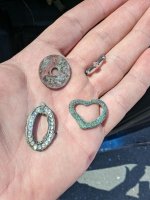Thomas007
Hero Member
RICHMOND, Va. - A man who sold Civil War relics that included munitions was killed by an explosion, and residents of the neighborhood were kept out of their homes Tuesday as experts looked for more explosives.
Samuel H. White, 53, was found in his backyard Monday by neighbors who had heard the blast, Chesterfield County police said.
Police Capt. Steve Neal said that what exploded was military ordnance, possibly dating from the Civil War. Authorities found unexploded military ordnance at his house, and on Tuesday they were still collecting and detonating explosives.
White's business, Sam White Relics, advertised various relics for sale including Civil War artillery shells, cannonballs and bullets. His Web site says he would "disarm, clean, and preserve your Civil War period and earlier military ordnance" for about $35 each.
http://www.samwhiterelics.com/
Samuel H. White, 53, was found in his backyard Monday by neighbors who had heard the blast, Chesterfield County police said.
Police Capt. Steve Neal said that what exploded was military ordnance, possibly dating from the Civil War. Authorities found unexploded military ordnance at his house, and on Tuesday they were still collecting and detonating explosives.
White's business, Sam White Relics, advertised various relics for sale including Civil War artillery shells, cannonballs and bullets. His Web site says he would "disarm, clean, and preserve your Civil War period and earlier military ordnance" for about $35 each.
http://www.samwhiterelics.com/
Upvote
0




